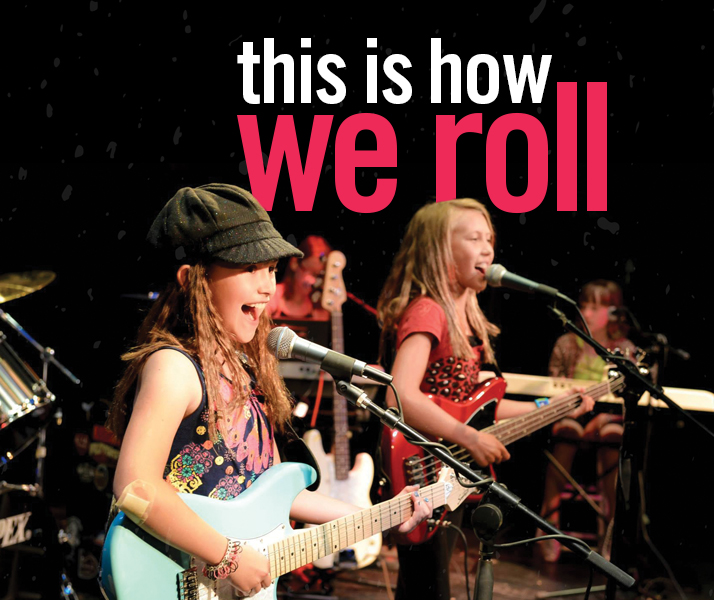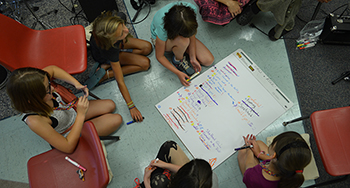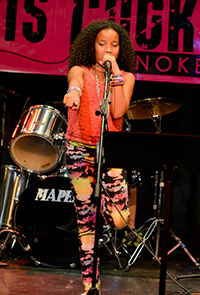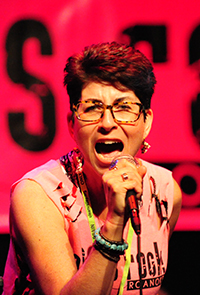
This is How We Roll
After Professor of Gender and Women’s Studies LeeRay Costa saw how transformative a rock ‘n’ roll camp was for her daughter, she brought it to Roanoke.
By Jean Holzinger M.A.L.S. ’11
Sometimes a punctuation point can make all the difference. Consider, for example, the difference between Girls Rock. And Girls Rock!
The first implies a quieter relationship between girls and rock ‘n’ roll—maybe even a sidelines role.
The second injects some energy into the equation, making it clearer that girls can play a more active role by composing, playing, performing—and even promoting—their music, starting from a young age.
LeeRay Costa, the mother of a music-loving daughter, envisioned this kind of experience for her child. A professor in the gender and women’s studies department, she stumbled across the Girls Rock! program, which originated in Portland, when Tallulah was only five, too young to participate. Still, Costa filed the idea away, and when Tallulah turned nine, Costa and her husband, Andy Matzner (who teaches in Hollins’ M.A.L.S. program), traveled to the nearest GR! camp, in Durham, North Carolina.
Inspired by her daughter’s rave reviews and by her own conversations with camp directors, Costa returned to Roanoke determined to start a Star City version of Girls Rock! “I talked to my good friend Kim Bratic [vice president of marketing at ALCOVA Mortgage in Roanoke], who has two daughters,” Costa remembers. “Immediately she was on board and willing to work with me to make it happen.”

Campers collaborate on their band’s name.
Although GR! camps exist all over the country and around the world, each develops its own curriculum. For the Roanoke camp (GR!R), Costa and Bratic began with a vision: “We wanted to use music and creativity as a vehicle to teach self-confidence, self-efficacy, healthy risk taking, and conflict negotiation,” Costa says. “We wanted to create a positive, uplifting environment for girls who in many ways in our society are being taught to compete with one another, to judge one another, to isolate from one another.
“We wanted to show there are other ways to be in the world.”
Their first GR!R camp launched in the summer of 2013, with full enrollment of 30 girls ages eight to 12—and with a waiting list. “It was an amazing experience,” Costa says, “so we decided: Roanoke seems interested.” After two years, they added a second camp for teen girls, ages 12 to 16. All girls are welcome, and an active fundraising program insures that no girl will be refused admittance because of an inability to pay. No previous music experience is required, either. The camp supplies it all: instruments, including keyboard, drums, bass guitar, electric guitar, and ukelele; instruction on singing and performance techniques; rehearsal time; and workshops on everything from poetry to dance, from mindfulness and social justice to self-defense. At the end of the week, each band performs an original song in front of a live audience.

Campers receive instruction on singing and performance techniques.
Certainly the girls are connected to each other through the music, but the sum of the experience is greater than its parts. “I think that girls are not necessarily used to being in a really supportive environment,” says Costa, “so many activities during the week are about building community. At the end of the week, they feel connected and valued. There’s a lot of tears and a lot of love.”
Costa, who has served in every role (except music teacher) in the organization, has seen firsthand the profound impact the camp has had on participants. What she didn’t expect was a similar kind of impact on the adults. “We are an intergenerational organization,” she explains. “The youngest campers are eight, and the oldest volunteers are in their 60s or 70s. So we have this community of people working together, across backgrounds and across generations.” Watching the campers grow in courage and confidence over the week seems to inspire in them a similar reaction. “Learning how to speak up for ourselves, take risks, learning how to try things that scare us, [figuring out] how can we be good friends and create community together—all of those things are happening for the adults as much as for the girls,” says Costa. “It provides support and confidence for each of these people to go out and do other things in their life that maybe they wouldn’t have done before.”

LeeRay Costa singing lead in a song she and her band mates wrote during a women’s rock retreat in North Carolina. (Photo by Parvinder Sethi)
And that goes for Costa herself. After the second or third summer of GR!R, she and several other camp volunteers attended a women’s rock retreat in North Carolina to see for themselves what it was like to compose, play, and perform music. What Costa found was that it was “really hard and really scary, especially if you’ve never played an instrument before.” She also discovered how empowering the experience can be. She played bass in a band called Throwing Heat, and sang lead in a song the women wrote and titled “Hormone Whiplash.” “It was a punk song,” she says, “and it was very cathartic.”
Now that GR!R has its feet firmly on the ground after five summers of camps and an expansion to year-round programming, Costa is taking more of a backseat role. Having studied nonprofit organizations for her doctoral dissertation, she knows they can suffer from “the founder problem” when the person who started it all has trouble “stepping away and letting go. From my perspective, for the organization to continue to grow and evolve, we need new energy and people and ideas,” she says.
Costa credits GR!R volunteers—the workshop leaders, the roadies, the fundraisers, the board members—with the organization’s success. Their participation is vital, she says, because “we want our campers to see women filling all of these roles. So often in the music industry, it’s a boys’ club. Music spaces are not necessarily inclusive of girls and those who may be just learning new skills and the language that goes with it.
“We want to provide girls with a foundation that will encourage risk-taking, and for them to see women involved in all aspects of music making, from the technical to the performance.”
Jean Holzinger is guest editor for this issue of Hollins magazine.
(Photos by Siobhan Cline, DrumzandSpace Photography)
